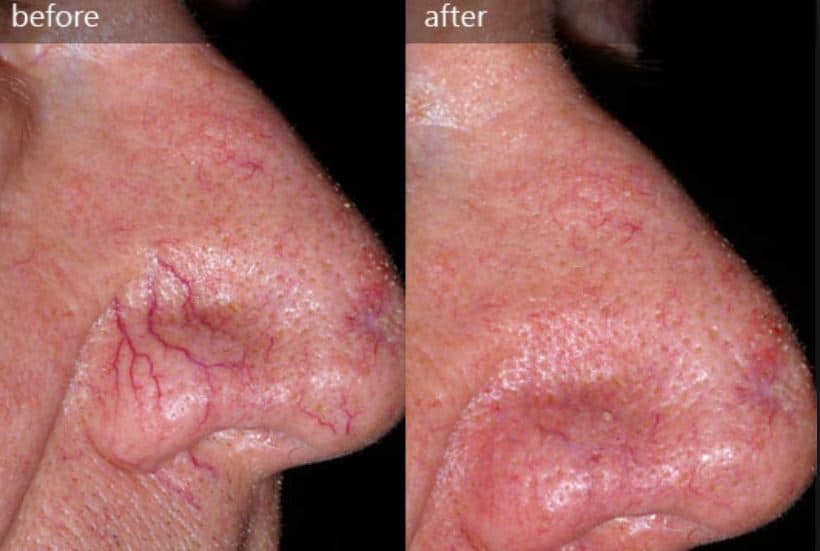The nose is a distinct part of the face. Therefore, the appearance of any skin condition makes one self-conscious and can be a cause of anxiety.
The veins on the nose are commonly known as spider veins (Telangiectasia), or thread veins. They appear small, dilated, and broken, resembling a “tree-branch”.
Causative factors
Table of content
The exact cause of them on the nose is unknown. However, there are several factors that can lead to the appearance of blue, purple, or red veins on the nose. These factors in include:

Drug use (Drinker’s nose)
There is a growing trend of men developing the drinker’s nose. This is the appearance of thread nose and often develops due to alcohol use, smoking, rosacea, or sun exposure. What’s in alcohol you ask? Well, excessive drinking of alcohol disrupts vascular control in the body and leads to circulation problems. Blood vessels are fragile structures. As a consequence, chronic alcohol use leads to capillary fragility. Their appearance is one clear indication of capillary fragility. Similarly, smoking disrupts blood movement
Sun exposure
Frequent exposure to the sun can lead to the appearance of redness or broken blood vessels on the nose. The UV rays wear out the skin thereby exposing the blood vessels on the nose.
Hormone changes during Pregnancy, Puberty, & Menopause
Hormone changes that occur during pregnancy, puberty, and menopause can lead to the appearance of veins on the nose. During pregnancy, there is an increase in the level of progesterone. Similarly, there is an increase in the volume of blood in the body. This high blood flow can add pressure to the veins leading to weakening them.
Alternatively, during menopause, the loss of collagen and elastin in the skin and the tissues on the nose lead to their appearance in this area and sometimes other areas of your face and body
Women who are currently undergoing hormone replacement therapy, or are taking birth control pills are also likely to notice the appearance of veins on the nose.
Aging
Aging leads to thinning of the skin on the face as well as the loss of collagen and elastin. Their appearance is also as a result of the weakening of the blood vessels and loss of collagen and elastin proteins in the skin.
Genetics:
There are people who were born with weak vein valves. As a result, they face a large likelihood of experiencing the appearance of veins on the nose.
Other possible factors that can lead to their appearance include rosacea. This skin condition triggers redness on the cheeks and nose. Rosacea is a common chronic, incurable condition that can be triggered by alcohol use, smoking, and eating spicy foods. They can also be due to obesity. People who are obese have a high risk of experiencing them due to the pressure in the body caused by the high adipose tissue.
The capillaries on the nose are sensitive and therefore they are susceptible to damage. A simple trauma such as pressure on the nose from wearing eyeglasses can lead to the appearance of spider veins on the nose.
Treatment Options for thread veins on the nose
Sclerotherapy is the standard treatment option for veins on the nose. This minimally invasive procedure involves injecting a solution (sclerosant) into the spider veins. The solution causes them to collapse. The collapsed one fades away with time. The technique costs on average $300 per session.
There are other available techniques such as laser treatments. Laser treatment will involve several sessions. Here, laser energy is used to make the veins fade with time. A pulsed dye laser is a preferred technique for thin red, veins that are close to the skin’s surface. This technique costs about $450 per session.
Electrodesiccation is another option. Here, the dermatologist uses electric energy to destroy the broken blood vessels.
There is a new technique that involves the use of a device known as vein wave. This technique uses thermo-coagulation to eliminate them. The device contains some tiny needles that heat the tiny broken blood vessels leading to their collapse. Unlike sclerotherapy, this technique does not cause discoloration and happens to be less painful. On the downside, it is more expensive compared to sclerotherapy ($400-$800 per session).
Most insurance companies do not cover for treatment of veins on the nose as they consider the issue a cosmetic one. However, there are instances where it can be covered, for instance, if it occurs alongside other venous conditions.
Tips to bear In Mind
- Use a sunscreen with a broad SPF to protect you from the harsh UV rays. Most fair-skinned people develop them due to exposure to the sun.
- Avoid triggers such as excessive alcohol consumption, smoking, and spicy foods.
- Avoid the use of topical steroids as they can trigger the development of rosacea.
- For women, it is advisable to consult a physician if you are on birth control pills or hormone replacement therapy.
- Adopt a nutrient-rich diet. Vitamin K and C are great for the skin as they help in strengthening of the blood vessels.
Consult a dermatologist to determine which treatment option is best for you. Be safe. Sometimes, cheap does not necessarily mean quality care, and other times, expensive may not be worth it. Therefore, look for a professional medical practitioner who will not give you a raw deal. Lastly, bear in mind that veins on the nose are stubborn and would require time to get rid of.
References:
- https://www.aad.org/public/diseases/acne-and-rosacea/rosacea
- https://www.skintour.com/face-focus/nose-issues-broken-blood-vessels-redness/
- https://www.livestrong.com/article/89602-treat-spider-veins-feet-/
- https://www.liverdoctor.com/alcohol-affect-way-look/
- https://www.veindirectory.org/content/laser-and-light-treatments/veinwave
- https://www.realself.com/question/whats-best-way-get-rid-spider-veins
- http://www.tandurust.com/skincare/spider-veins-on-nose-causes-remedies.html
